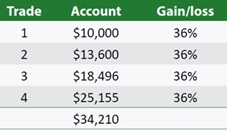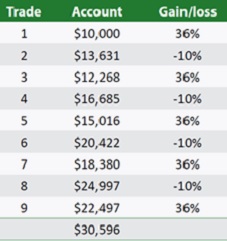Super-genius Albert Einstein called it “the eighth wonder of the world”…
Legendary investor Warren Buffett attributes his $116 billion fortune to this force…
And it’s how investors from all over the world have turned small stakes into millions of dollars...
I’m talking about “compounding.” But not in the way you’re probably thinking.
Most of us learned about the power of “compound interest” in school.
$10,000 compounded at 5% per year grows to $16,289 in 10 years...
$26,533 in 20 years...
$43,219 in 30 years.
Compounding works in dividend-paying stocks, too. You buy shares in a rock-solid company like Apple (AAPL)... and consistently reinvest the dividends to buy more stock. In 30 to 40 years, you’ll have a lot more money than you started with.
But what if you don’t have 30 years to wait around?
- In this essay, I’ll show you an easy way to speed up the power of compounding. I call this strategy “compounding capital gains.”
Before I continue, fair warning: This is an unconventional approach.
Most haven’t considered it. But even if they fully understood how lucrative it can be... the vast majority still wouldn’t follow it... because it’s human nature to want to spend your trading profits.
I’m suggesting you do it differently than most folks.
I’m suggesting you save and reinvest some or all of your winnings from one trade into the next trade, in order to snowball your account more quickly.
Do this well, and you’ll enjoy “compound interest on steroids”...
I’m talking about the kinds of gains that normally take years or decades to realize.
You might be thinking:
- “Justin… to bag big, quick gains, don’t you need to take on huge risks?”
Not necessarily, if you follow my golden rule of trading.
Let me show you...
This is an extreme example, but let’s say the average gain across all your trades over the last year (counting the winners and the losers) is 36%.
Now, imagine you strung together a couple of those 36% winning trades in a row. But instead of spending the profits, you rolled them all into the next trade.
How many trades do you think you’d have to string together to triple your account?
You may find the answer surprising...
It would only take four trades to triple your trading account from $10,000 to $34,000:

- Of course, there are some problems with this oversimplification:
- Gains are never this smooth.
- You wouldn’t necessarily roll all your profits into the next trade.
- You’ll certainly incur losses along the way.
So, let’s assume you didn’t string together a bunch of winners.
Let’s assume you incurred some losses but followed my golden rule of trading: Cut your losing trades early.
In this new scenario, let’s say you got a 36% win... followed by a 10% loss... and then that pattern repeated.
After nine trades—even though nearly half were “duds”—your $10,000 would still turn into $30,000:

Nine trades and you’ve tripled your account.
Again, this is an extreme example. Your results will vary depending on a number of factors, including how disciplined you are, your starting investment, current market conditions, etc.
But it goes to show just how lucrative compounding can be. And it gives everyday investors the opportunity to grow even a modest next egg over time.
- Let me show you how I recently used this strategy with my premium readers.
In May, Shopify (SHOP) experienced a strong rally on the back of excellent quarterly earnings.
By the time the results were reported, SHOP had already climbed 33% since we first added it to the portfolio.
But following this explosive move higher, SHOP looked pretty extended. And I knew a pullback after such a big run-up would be perfectly normal and healthy.
So, I told readers to sell ¼ of our SHOP position.
Not only did this take some risk off the table, but it freed up some capital that we could roll into one of our other positions.
And this brings me to an important point…
If a stock suddenly loses steam for any reason, that’s OK. You can simply take your gains and reinvest them into the next opportunity like we did with SHOP.
Your goal is to achieve a “snowball effect” where your account balance can compound faster and faster.
Have you tried this strategy before? Let me know how it went at justin@riskhedge.com.
Justin Spittler
Chief Trader, RiskHedge





